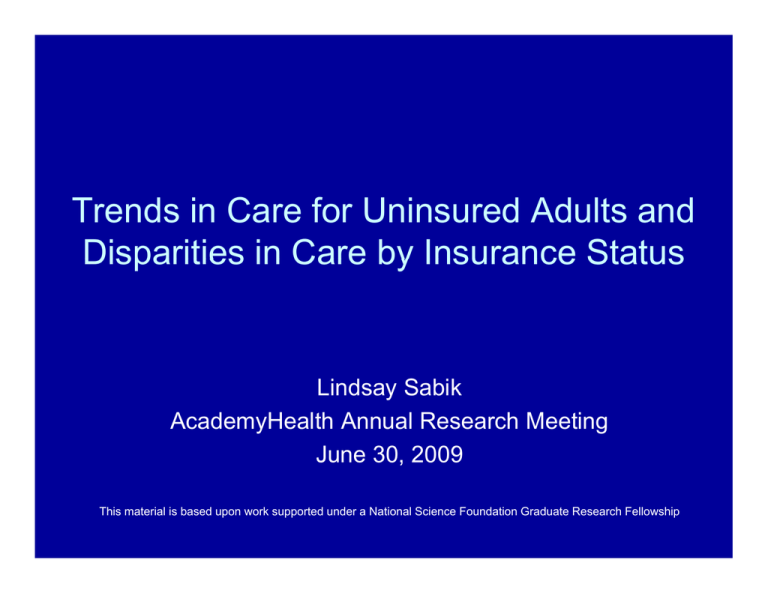Trends in Care for Uninsured Adults and
advertisement

Trends in Care for Uninsured Adults and Disparities in Care by Insurance Status Lindsay Sabik AcademyHealth Annual Research Meeting June 30, 2009 This material is based upon work supported under a National Science Foundation Graduate Research Fellowship Outline • • • • Background and motivation D t and Data d methods th d Results Summary and discussion Background and motivation • Uninsured population increasing over time • With costs projected to increase, number of uninsured likelyy to continue rising g • Compared to the insured, uninsured individuals – receive fewer and less timely services – are less likely to receive preventive care – have worse outcomes • Existing research is primarily cross-sectional Trends in care for uninsured • Ri Rising i costs t are associated i t d with ith – Advances in medical technology Improvements in treatment Increasing costs per treatment episode – Increasing insurance premiums Rising number of uninsured • Tension between improved standards of care and increasing financial strain on system Research questions 1) How is care for the uninsured changing over time? – Absolute trends indicate whether system maintains a minimal level of care through safety net 2) How are the differences in care received by the privately insured and uninsured changing? – Relative trends indicate how disparities by i insurance status t t are changing h i over titime Data Access: Communityy Tracking g Study 1996-2003 Chronic Care: National Health and Nutrition Examination Survey 1999-2006 Acute Care: National Hospital Discharge Survey 1996-2006 1996 2006 Analytic approach ((1)) Restrict sample p to uninsured individuals and estimate: Pr (Yit) = Φ (β0 + β1Xi + β2t + εit) ((2)) Include insured and uninsured individuals and estimate: Pr (Yit ) = Φ (β0 + β1Xi + β2coveragei + β3t + β4coveragei·t + εit) where Yit = outcome (access/treatment/control) for person i at time t; Xi = vector t off individual i di id l covariates i t (age, sex, race, income, etc); coveragei = 1 if privately insured, 0 if uninsured; t = indicates the time period of the observation; εit = error term. Changes in uninsured population • Changing population of uninsured affects changes in care over time • Attempt to control for these changes: – Focus on measures incorporating potential demand for care – Focus F on sub-populations b l ti off uninsured i d with ith similar i il underlying health status – Include individual-level covariates that control for observable characteristics associated with health status and demand for care CTS sample demographics Year Age % Male % Nonwhite Family Income General Health (1-5) 1996 1998 2000 2003 1996 1998 2000 2003 1996 1998 2000 2003 1996 1998 2000 2003 1996 1998 2000 2003 Privately Insured (Percent or Mean) 39.9 39.7 40.1*** 40.1 40.9*** 49.8% 49.5% 49 6% 49.6% 49.1% 21.7% 23.1%*** 22 9% 22.9% 23.4% $49,611 $54,100*** $59 941*** $59,941*** $63,344*** 2.14 2.16** 2 20*** 2.20*** 2.21 Uninsured (Percent or Mean) 34.8 35.2 35.1 35.9* 53.5% 51.9% 52 7% 52.7% 55.3%** 43.8% 46.1% 46 7% 46.7% 50.7% $19,571 $19,827 $24 010*** $24,010*** $24,193 2.48 2.50 2 56** 2.56** 2.57 Data from the CTS; Includes individuals ages 18-64; *** p<0.01, ** p<0.05, * p<0.1 in tests of whether value is significantly different from previous year within insurance category; General health: 1 = Excellent, 5 = Poor. Forgo care Access ccess to o ca care e • No significant change in probability of forgoing or delaying care for uninsured Forgo or delay care • Compared to privately insured, uninsured have – 9 9.5 5 percentage point higher probability of forgoing care – 13.6 percentage point higher probability of forgoing or delaying • No significant changes in gap Cholesterol control Chronic disease control (1) • No significant change in cholesterol or glycemic gy control among uninsured • No significant difference between privately insured and uninsured on average Glycemic control • U Uninsured i db become worse off relative to privately insured – increase in gap of ~2pp per year for cholesterol control (p<0.05) – ~1 1 pp per year ffor glycemic l i control (not significant) Chronic disease control (2) Blood pressure control • Both uninsured and privately insured show improvements in blood pressure control • Gap narrows, though not significant on average • ~ 8.1 p percentage g p point gap remains at end of period Invasive care post-AMI post AMI Invasive AMI care • Both uninsured nins red and privately insured improving • No significant difference between g groups p on average • No significant change in gap between groups Summary of results • No significant improvement or decline for uninsured for most outcome measures – Flat trends in access; diabetes, cholesterol control – Exceptions: BP control and post-AMI care • Gaps between uninsured and privately insured constant or widening on most measures Limitations • Surveyy data limitations – Access measures from CTS and diagnosis measures from NHANES based on self-report – All data are pooled cross-sections • limits ability to control for changes in population over time • Number of possible mechanisms may be driving trends – e.g. privately i t l iinsured d may b benefit fit ffrom di disease management programs Implications for policy • Disparities in access to care and chronic disease control by insurance are not improving over this period • Efforts to improve care for the uninsured (e.g. expanding community health centers) have not narrowed gap for most measures • Uninsured are not worse off in an absolute sense, but are relatively worse off on some measures – Raises question of whether widening gap is acceptable